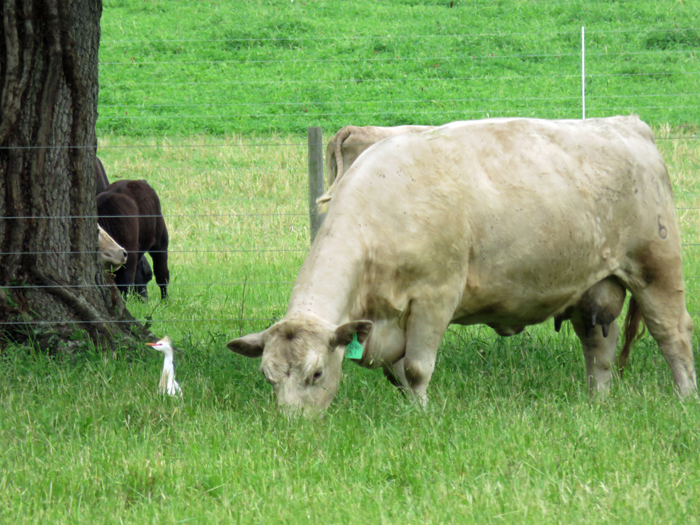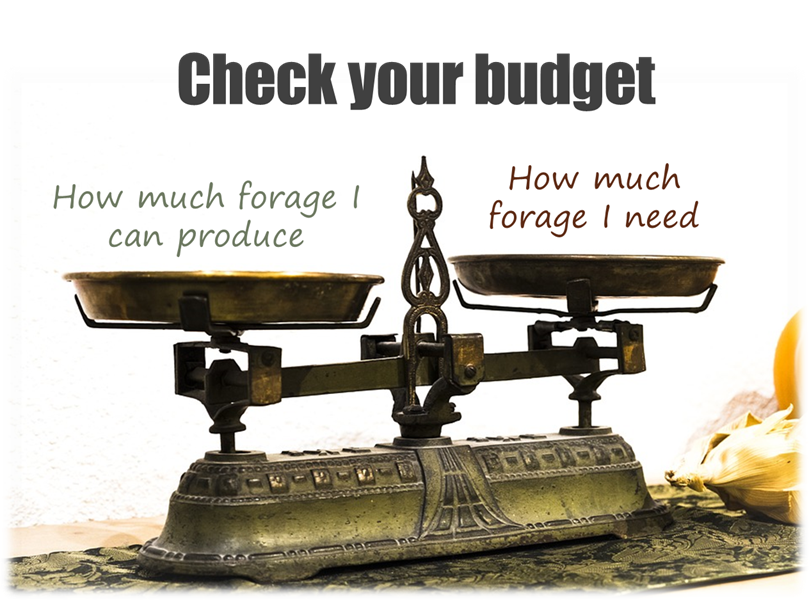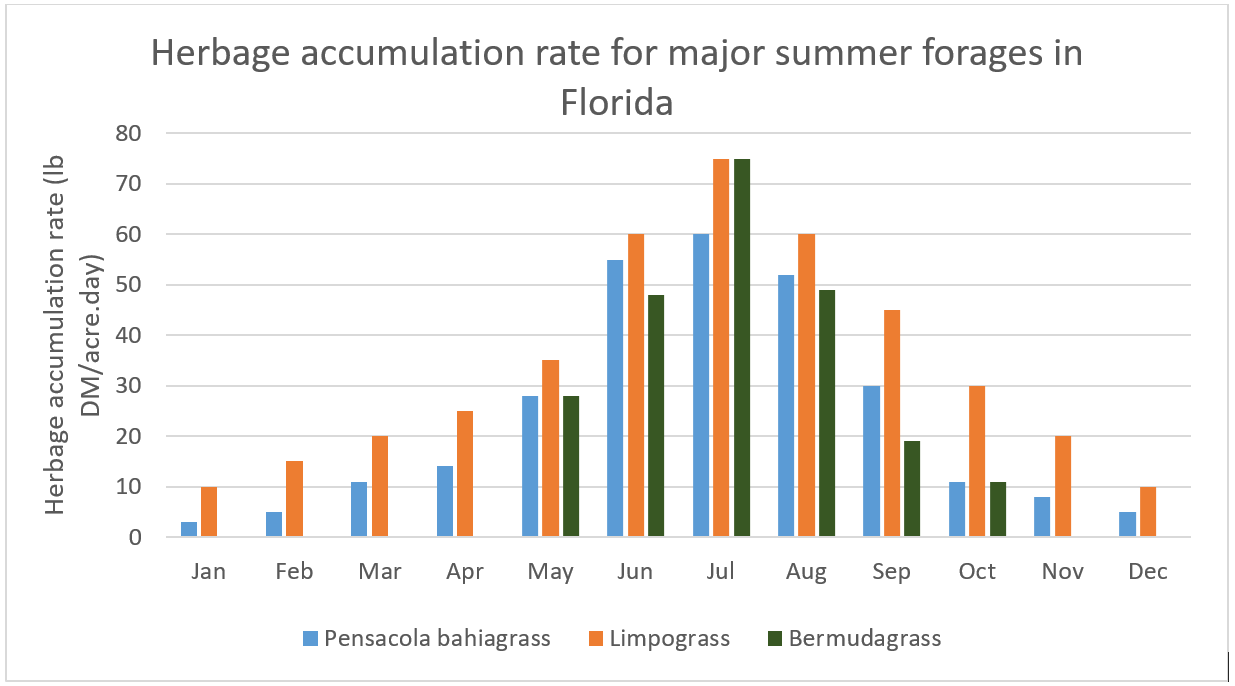
Commercial cow grazing at the North Florida Research and Education Center, Marianna. Credit: Doug Mayo
Marcelo Wallau – UF/IFAS Forages Extension Specialist, Caitlin Bainum – UF Agronomy Department MS Student and Marion Co. Agriculture & Natural Resources Extension Agent, and Liliane Severino da Silva – UF Agronomy Department PhD Student
It is never too early to start planning. As summer approaches, our main forage growing season in Florida, there are a few steps to be taken to ensure you have a great season and get the most out of it productively! Stuth et al. (1991) divided resource planning for grazing lands into long-, medium- and short-term plans. Long-term is the strategic planning, defining objectives, goals, focus animal category, markets, policies, financing and land improvement investments. The medium-term is the tactical planning, where we define the forage budget, needs and supply of forage, stock adjustment, nutritional balance and health management. Last, is the day-to-day, the short-term, the operational planning. At this point, we assess forage supply, identify needs for restocking or destocking, or supplemental feed for nutritional mediation, and health treatment. Flexibility is the key word for this level, so we can easily correct eventual problems. Here, we will focus on medium-term planning that can help you get the most out of this next grazing season.
First, evaluate your pasture conditions – Think about the history of your pasture, how productive it was last year, the challenges faced, how was the management in terms of grazing, fertilization, weed control, etc. If you encountered problems last year, more likely they will repeat this year, unless you mitigate them. Last year was quite challenging for most parts of Florida, starting with a drought over spring and summer, then with excessive water leading to flooded pastures for the remaining of summer and into early fall. Those disturbances could have imposed significant stress to your pastures, leached nutrients and even reduced persistence by reducing the amount of energy reserves for the plants. All of this could mean that you are in for a late start this year. Overgrazed pastures will have a similar effect, with reserves depleted, they will take longer to start greening the following spring. This can result in higher weed pressure and further delay grazing. Thus, soil test and check what nutrients are missing, and plan your applications for early in the season, when plants are starting to grow, so they can use the nutrients, especially nitrogen, better. Many problems on pasture persistence, disease or insect susceptibility are linked to deficiency in potassium (K), for example. Talking about weed pressure, was there any weed problem last year that could be addressed now? For some weeds, hitting them in the beginning of the season can result in better control and less expense. Scout for weeds, ID them, and consult your extension agent on which is the best product and strategy that suits your needs.
1 – Calculate your forage budget
Like your bank account, you need to have a balance between resources available and demands. If you need more forage than you can produce, then you are in the red, which will cost you money in importing supplies. So, first, calculate your forage supply to learn your carrying capacity. Create an excel spreadsheet, map your areas, evaluate the conditions of your pasture and calculate how much forage you can produce. Figure 1 provides some general values for daily herbage accumulation rates (lb of dry mater [DM] per acre per day) that some of the most common species in Florida produce. Those values change according to fertilization rate, water availability and grazing management, but are a good reference for starting a forage budget. Remember to always leave 1200 lb of DM/acre as stubble, in other words, use only 50 to 60% of the accumulation rate, to ensure that you have enough forage for your cattle as well as the plant’s demands for surviving. Another way to look at it is to always offer 2 to 3 times more than the animal needs to consume per day.
The second step is to determine your demand both in terms of quantity and quality of forage needed. This way you can adjust your management practices, use techniques to enhance the nutritive value of forages produced, and finally, see if there is need to reduce or expand your herd accordingly. Take into consideration that your cattle need to eat around 2.7% of their body weight in dry matter per day (between 2 and 3%, depending on forage quality and physiological stage), and that dry cows need significantly lower quality forage (8% crude protein) as compared to lactating cows and growing animals (12 to 16%).
The third step is to calculate the balance between supply and demand for forages. In many cases, demand for forage exceeds supply, requiring destocking, or finding extra sources of feed in the form of supplement, hay, or extra pasture. If you have extra supply, then there could be an opportunity to retain or purchase more animals, or harvest for hay or haylage. Nitrogen fertilization can increase the quantity and quality of forage produced. But remember, no management practice for the pasture (fertilization, rotational grazing, etc) will overcome overgrazing.

Figure 1. Herbage accumulation rate (lb of dry matter [DM]/acre.day) for bahiagrass and limpograss (Gainesville, FL) and bermudagrass (Marianna, FL) (data courtesy of Drs. José Dubuex and Lynn Sollenberger).
2 – Plan your pasture utilization strategically
Think about your farm as a mosaic of different soil patches and pasture types, and plan forage management to match your property to optimize pasture use along this mosaic over the year. Some forages, like limpograss, for example, are more adapted to lower areas susceptible to periodic flooding. Those areas are also generally wetter in the spring. This means that limpograss could be an early starter and also a late player, with possibility for stockpiling forage for fall use. Protein, however, is very low, so factor in using this with mature cows and the need for protein supplementation. Bermudagrass has production more concentrated in the summer months, and is an excellent forage for growing animals, like weaned calves and replacement heifers, for example. For summer pastures overseeded with cool-season forages, remember to reduce competition (graze down the cool-season forage) towards the end of the spring, so you can reduce competition for your bahiagrass or bermudagrass. Also think about the areas that could be used for cool-season forages next fall, and manage them accordingly. When you start thinking about the farm as a whole, with different forage species and management strategies, it becomes easier to fit the different pieces together and make a system.
3 – Keep it simple and flexible
Simple strategies can solve many problems! Before implementing more advanced management techniques, do the simple steps first. Again, no management practice can overcome excessive grazing, and any applied management will have the response limited by the lack of forage. So, start with the forage budget, then think about fertilizing your pastures, supplementing your cattle, and then move on to more complex management systems. And, always keep it flexible, leave room for error and unexpected events. Expecting too much or working close to the limit of forage availability can be risky, any change in weather or market prices that requires you to retain cattle longer can have some serious implications in your system. Different than cattle, pastures don’t have compensatory gain, and mismanagement can set you back half a year or more.
4 – Assess, evaluate, and re-assess
You can only improve what you can measure, so take notes, measure your pasture productivity and animal performance, record and evaluate that in comparison to your goals. Those notes will help you for next year’s planning. Make sure your goals are in accordance to your production capacity.
Resources:
Basic Nutrient Requirements of Beef Cows
Bermudagrass Production in Florida
UF/IFAS Standardized Fertilization Recommendations for Agronomic Crops
Weed Management in Pastures and Rangeland
Reference: Stuth, J.W.J. R. Conner, and R. K. Heitschmidt. 1991. The decision- making environment and planning paradigm. In Heitschmidt and Stuth, eds. Grazing management. 201-24.
- 2025 Southeastern Hay Contest Sets New Records - October 24, 2025
- 2025 Cool-Season Forage Official UF/IFAS Variety Trial Results - September 5, 2025
- Revisiting Crop–Livestock Integration in the Southeastern United States - September 5, 2025
